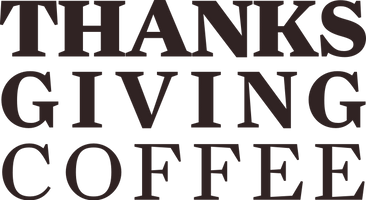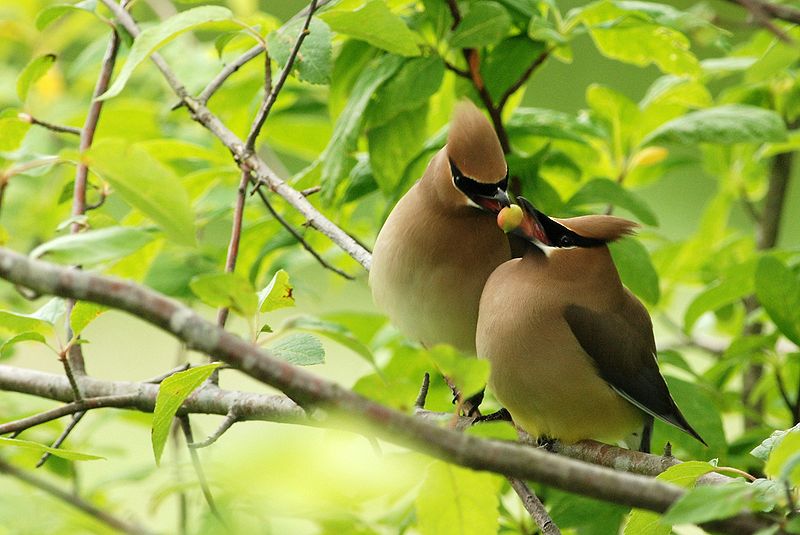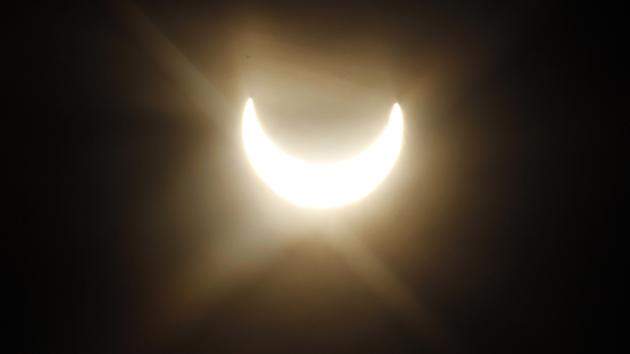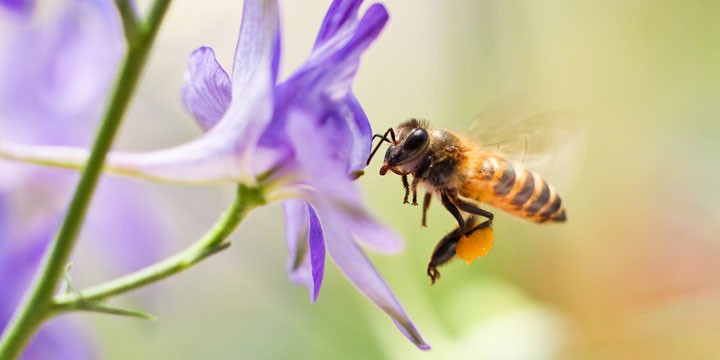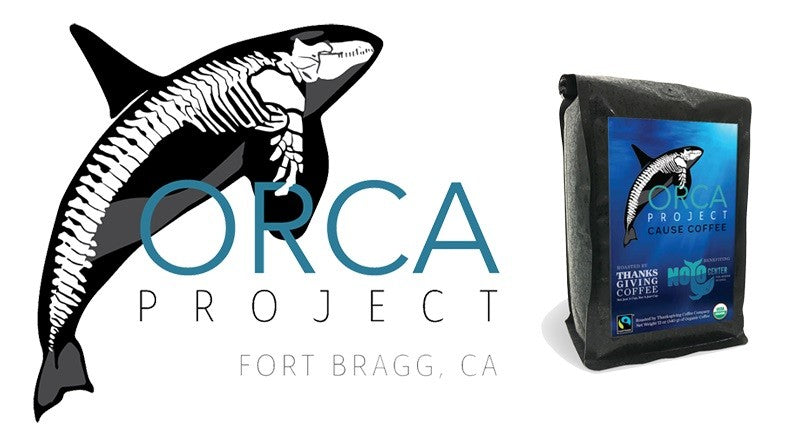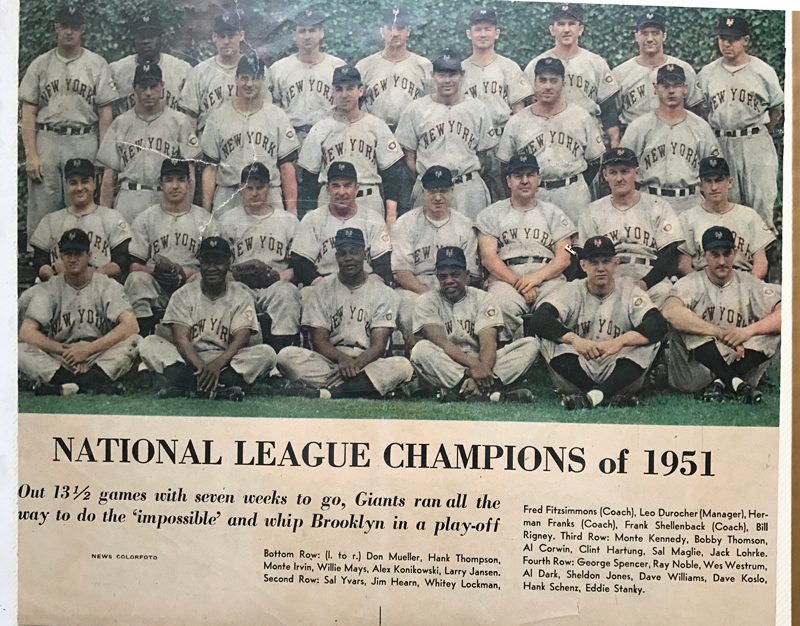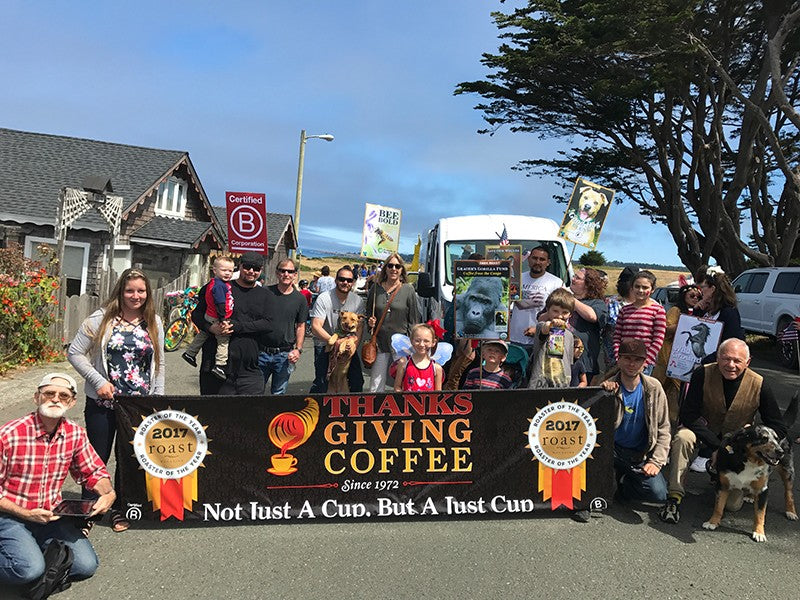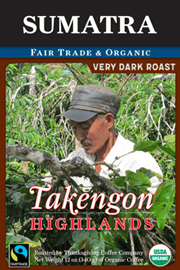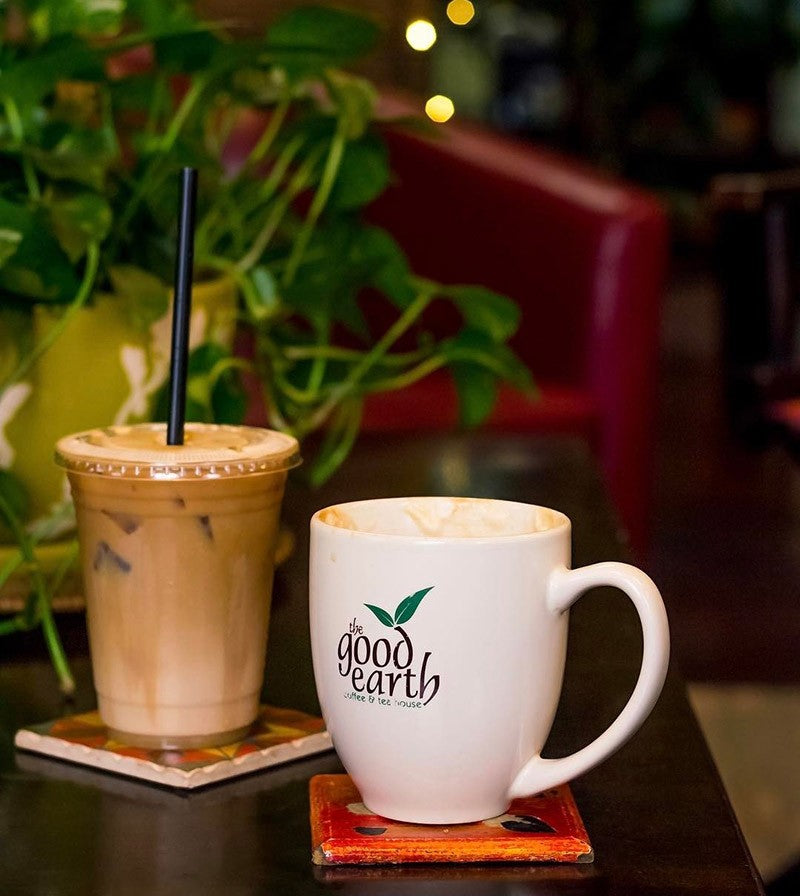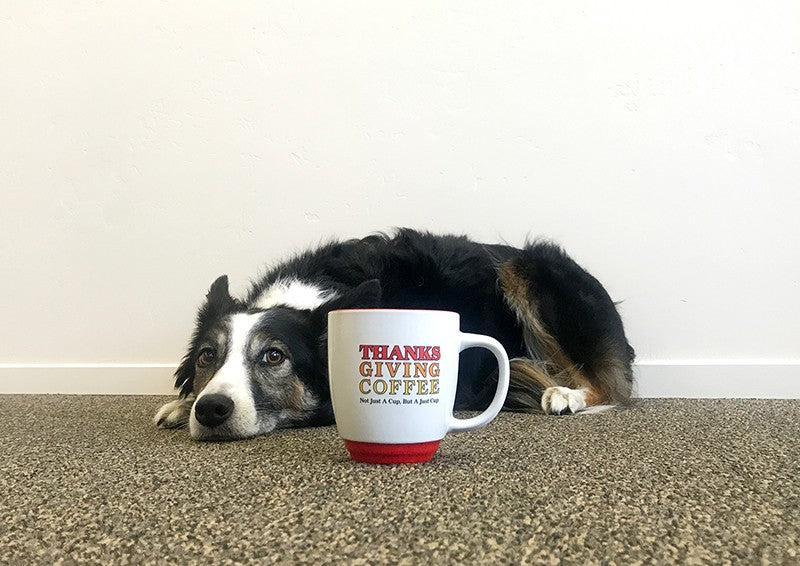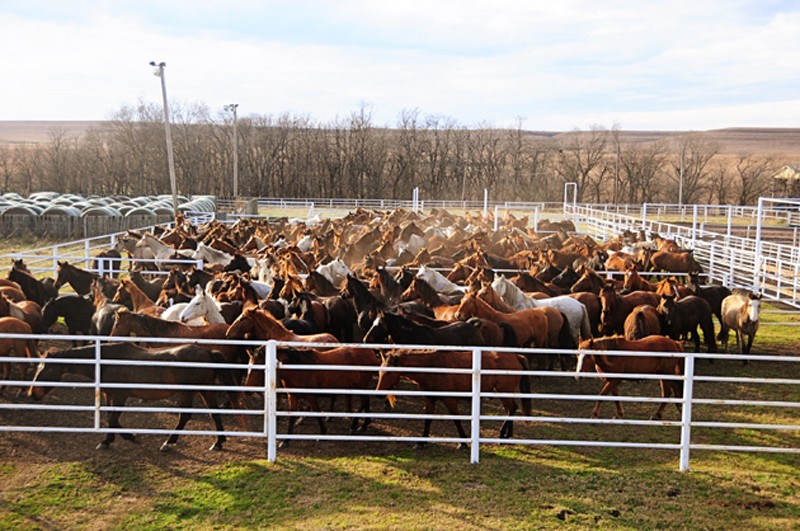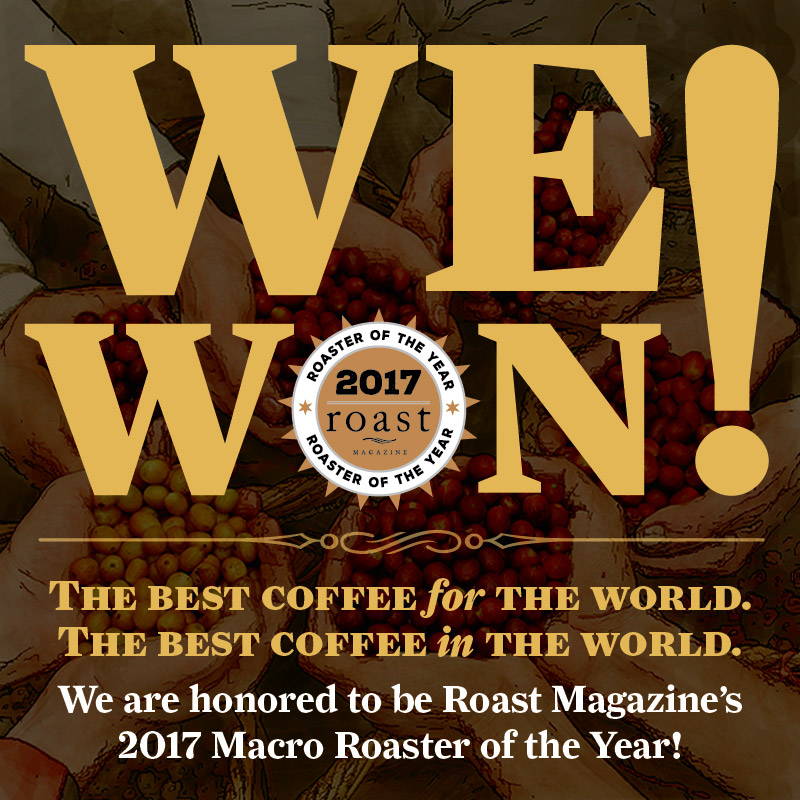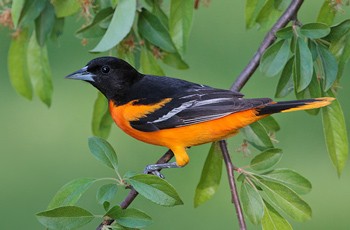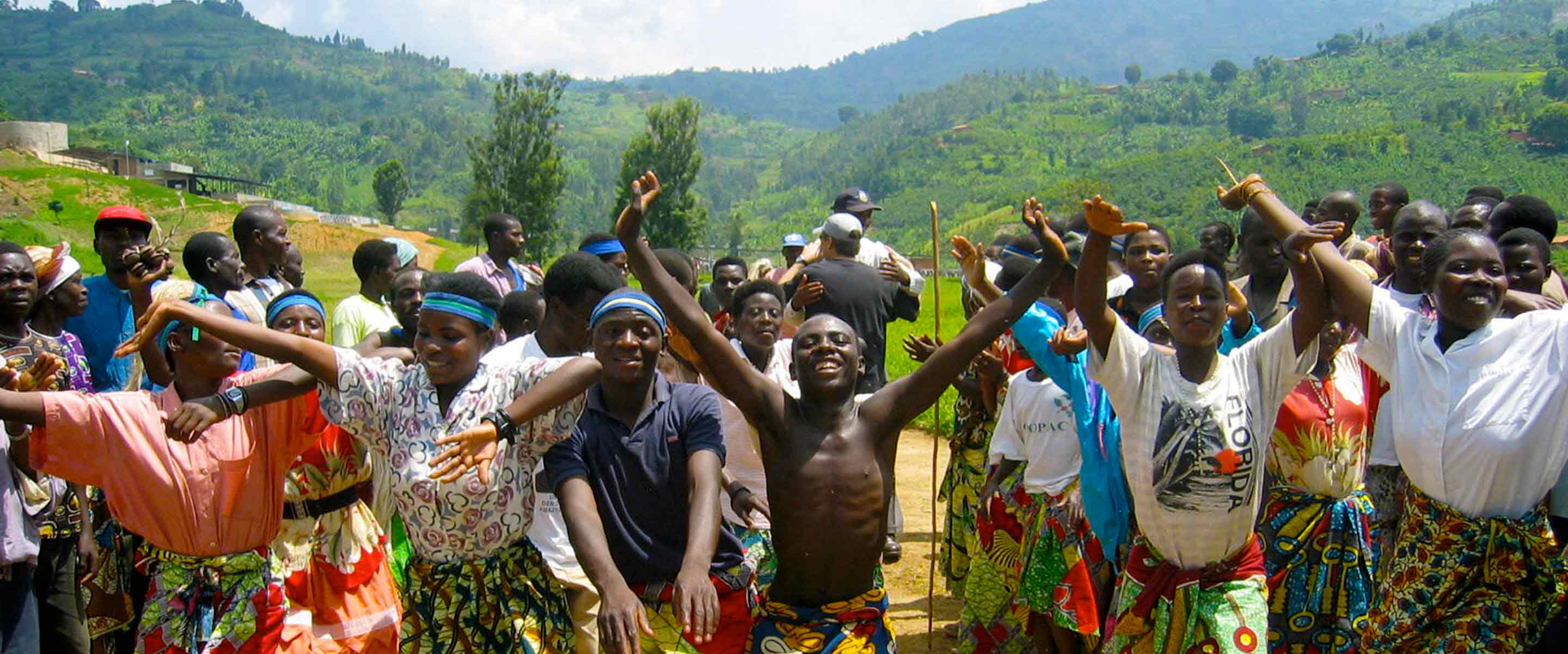
News, Stories and more
Our Blog
View BY :

BREWING COFFEE
Just like in our coffee grinding blog, there are some basics we have to go over first. So, before we get into how to brew your own “just cup”, let’s go over those basics. I’d also like to thank the many Thanksgiving employees who contributed info from past articles so that we could have this educational piece on brewing delicious coffee: Jacob Long, Marchelo Bresciani and Paul Katzeff.
1. Coffee to Water Ratio
“What? I’ve just been pouring copious amounts of grounds into a filter and adding a few cups of water.” I’d like to think we’ve all been there. At least I have, before I started working at Thanksgiving Coffee Company. But hopefully we caught you early enough to steer you in the right direction. 😉
Using the correct amount of coffee will ensure that your coffee is brewed to strength, without over-extracting or under-extracting the coffee to compensate for an inappropriate dose. While we do recommend weighing 2 grams of coffee for every fluid ounce of water, we understand that not everyone has a scale at home. And if you don’t, just estimate about 2 heaping tablespoons of ground coffee for every 5 ounces of water used to brew.

2. Grind Size (yes, this again)
This is one of the most important steps in coffee brewing. In general, a finer grind will produce a more intense brew and a coarser grind will produce a less intense brew. At the same time, a grind that is too fine will produce an over-extracted, astringent brew, and a grind that is too coarse will produce a weak, under-extracted brew lacking flavor. In pour-over methods, grind size also affects the rate of extraction, as water will pass more slowly through a finer grind, and more quickly through a coarser grind. We strongly recommend burr grinders over blade grinders. For more information on this, see our last blog “How to Grind Coffee“.

3. Water Temperature + Quality
This one is a little bit more straight-forward. Water temperature dramatically affects the extraction of coffee’s flavor during brewing. We recommend brewing with water at 200° Fahrenheit for best results. Using fresh, clean, chlorine-free water is essential.

4. Coffee Freshness and Storage
Coffee is very sensitive to heat, moisture, and oxygen. It should be stored at room temperature in an airtight container. For best results, grind coffee fresh, just before brewing.
Staling is caused, in order of most harmful to least harmful
- Exposure to air (Oxidization)
- Exposure to heat
- Exposure to moisture
- Exposure to light
…and, if you address the problems of Air, Heat, and Moisture correctly, then Light will have little effect on your coffee. Read more about storing your coffee here.

5. Cleaning
This is the last one – of the basics – and it’s pretty easy. Because coffee contains numerous oils that build up over time, we recommend thoroughly cleaning your brewing and grinding equipment after each use. This guarantees the best, freshest cup of coffee every time.

So… we covered all the basics. I know it’s a lot, but we still have all of the brewing methods to cover from stovetop espresso to cold brewing. Stay tuned for part two, and we’ll help you discover which method is best for you and why.
Coffee Tips : How to Brew Coffee - Part I
BREWING COFFEE Just like in our coff...
read more-
![Featherbed Railroad wins TripAdvisor Certificate of Excellence!]()
Featherbed Railroad wins TripAdvisor Certificate of Excellence!
We want to offer congratulations to our friends at Featherbed Railroad Bed and Breakfast. This unique place to stay in Northern California is a truly magical experience every time… and Tripadvisor has confirmed it by awarding them the 2017 Certificate of Excellence.
This award verifies what we already knew about this great bed and breakfast: they are spectacular. The certificate is awarded only to hotels, businesses and attractions that have held their 4-5 star ranking for a significant period of time. Other items are taken into consideration, like how often the business is reviewed, and the quality of reviews they receive.
Tripadvisor states that “This recognition helps travelers identify and book properties that regularly deliver great service. TripAdvisor is proud to play this integral role in helping travelers feel more confident in their booking decisions.” Only 10% of hotels worldwide receive this recognition!
Thanksgiving Coffee and Featherbed Railroad
Featherbed Railroad has served Thanksgiving Coffee for the past nine years, and we are honored to be affiliated with such a spectacular bed and breakfast. Lake County is lucky to have such a great place for guests to enjoy on the shore of Clear Lake. The shot below is from a visitor on Yelp, sipping Thanksgiving Coffee and enjoying a great view from their caboose.

Check out what people have had to say on Tripadvisor:
“The 9-10 am breakfast was too late for us so our hosts cooked a special breakfast for us at 8. Delicious and piping hot! Great coffee and juice too. The sweet attentive resident dog added to the homey atmosphere and we were sent on our way with a wonderful memory.” “My husband and I stayed at Featherbed for 4 nights earlier this month, and enjoyed every minute of it. The owners, June and Paul, are phenomenal hosts. They’ve taken care of often-overlooked details in the room like large, soft towels, high-quality bedding, locally sourced and delicious coffee.” “I am a local, but stayed over for the New Year’s Holiday! What fun. I had the Tropicaboose and the bed and decor was fab! Breakfast with homemade sausage gravy, fruit, egg casserole and coffee (to die for!) was terrific.”
Photos from Lake County’s Featherbed Railroad
This bed and breakfast features individual caboose rooms for rent! Each individual train car has its own special theme, and each one is individual Take a look through some of their photos to see why it was called One of the most Unusual Hotels in the World by Escape Travel and one of the Ten Wackiest Hotels in the world by Hotels.com.


Check out their website and stay the night: www.featherbedrailroad.com
Featherbed Railroad
2870 Lakeshore Blvd
Nice, CA 95464
(707) 274-8378
Featherbed Railroad wins TripAdvisor Certificate of Excellence!
read more -
![Sing a Song of Bird Notes]()
Sing a Song of Bird Notes
Song Bird Coffee supports the arts
Do you have a favorite bird? Is it the bold blue jay, or the striking red cardinal? Perhaps it’s the mischievous raven, or the sweet singing sparrow? Maybe you don’t know what it’s called, or even what it looks like, but you know its song as it fills your ears with a familiar refrain. Birds connect us to nature, regardless of where we live; from city dwelling pigeons to dramatic California Condors, birds are an ever-present aspect of our lives, but their numbers are dwindling. You don’t have to be an avid birder to enjoy their presence, but if we fail to appreciate them in our everyday lives, then we risk taking them for granted and losing them forever.
Fostering a love of the natural world can take years, especially now when more of us live in cities than ever before. Programs like BirdNote cultivate a love of nature with a wide audience, helping to bring the outside into our homes and deliver the delights of nature in small, auditory morsels.
The BirdNote radio program has been engaging listeners of all ages for over ten years, sharing daily two-minute stories about birds and the environment with audiences all across the country. These uplifting little vignettes are just the right length for everyone to enjoy, and the perfect remedy to ‘news fatigue’.
BirdNote and Song Bird Coffee
Song Bird Coffee has been partnered with the American Birding Association for 20 years and together we have raised over $150,000 in support of the ABA and Partners in Flight, which funds ornithological studies of migratory birds in Central America. Together, we are making a difference by promoting citizen science, ecotourism, and sustainable Bird Friendly farming practices, and now we are proud to be reaching new audiences by sponsoring BirdNote.
By working together, Song Bird Coffee, the American Birding Association, and BirdNote are committed to making the world a better place, for us and for the birds.
Give BirdNote a listen here.
Learn more about the American Birding Association and Partners in Flight.
Sing a Song of Bird Notes
read more -
![Best for the World, Best for Community]()
Best for the World, Best for Community
It’s that time of year again, when the Best for the World honorees are published. These are the B Corporations around the world that score in the top 10% of B Lab certification. Thanksgiving Coffee was honored to make this list for the second year in a row in the Best for Community category.
Take a peek at the full list by clicking the image below.

This year 846 companies were recognized on the Best for the World list in 52 different industries from 30 different countries. Being a part of this community and being recognized in the top 10% is a really wonderful validation of the work we do with our partnership with organization like Friends of the Earth and the Dian Fossey Gorilla Fund International.
Take a look at where some of the other Best for the World companies are located all over the globe:

Best for the World in Mendocino County
Thanksgiving Coffee is just one of nine B Corporations located here in Mendocino County. We’re joined by Harvest Market, Fetzer Vineyards, North Coast Brewing Company, The Color Mill, Flo Beds, Bed Bandits, Eleek Sustainable Custom Lighting and Heather Paulsen Consulting.
Harvest Market also made the Best for the World list, under the Changemakers category, as did Eleek, under the Best for the Environment category. We love seeing our local B Corporations making a difference here in Mendocino county, and around the world.
Read more about what it means to be on the Best for the World list, on Forbes.com.
You can also check out our score on the B Corporation website, to see how we stand up in every category! See that here.
Best for the World, Best for Community
read more -
![Grauer's Gorillas in Congo's Maiko Park]()
Grauer's Gorillas in Congo's Maiko Park
Read the original Mariko Park blog post on the Dian Fossey Gorilla Fund International website.
Results of a recent wildlife survey led by the Dian Fossey Gorilla Fund in the Democratic Republic of Congo suggests there are twice as many Grauer’s gorillas in parts of Maiko National Park than originally predicted. This is especially welcome news given that Grauer’s gorillas are among world’s most-endangered apes and face numerous threats to their survival, with only a few thousand still remaining. Their population is estimated to have plummeted as much as 80 percent in recent decades.
The greatest threat to Grauer’s gorillas and other wildlife in the region is poaching, which is largely fueled by the illegal trade in conflict minerals. In 2010, legislation was passed which required U.S. companies to disclose whether their products contained conflict minerals. Just this last week, the U.S. House of Representatives passed an amendment that would defund this “conflict minerals rule.” If this measure is passed by the Senate, it will bring additional pressure to this species’ survival.
“Maiko is a huge park — with more than 10,000 square kilometers — and it is critical habitat to the future conservation of Grauer’s gorillas and many other species of wildlife,” says Dr. Damien Caillaud, the Fossey Fund’s research director for Congo. “Recent reports suggested as few as 15 gorillas remained. We hoped that if we looked for more gorillas there, we might find them. And we did.”
In the relatively small portion of the park that researchers were able to survey, they located evidence of more gorilla groups than expected and now estimate at least 30 gorillas live in that area, with likely more living throughout other areas of the park that have yet to be surveyed.
Maiko National Park is one of only two formally protected areas within the Grauer’s gorilla range. However, Maiko had not been surveyed for gorillas for many years, primarily as a result of security challenges in the region and the difficult terrain.
“We surveyed less than 1 percent of the park and found evidence that more gorillas exist there than has been recently suggested. This is very exciting and demonstrates the critical need for more surveys to fully understand how many gorillas remain as well as more conservation support for the park”, says Dr. Tara Stoinski, Fossey Fund president and CEO/chief scientist.
The survey team also found signs of chimpanzees, okapi, buffalo, duikers, giant pangolin, monkeys and other rare wildlife, as well as evidence of poachers and mining activity.
The Fossey Fund works to protect Grauer’s gorillas in a core area of their range outside national parks, by working with local communities and traditional landowners, and training local people to become gorilla trackers, with five teams now working regularly from a permanent base north of the town of Walikale.
Collaborating with local communities and authorities
The Maiko survey represents a collaborative effort between the Fossey Fund, the Congolese national park authorities (ICCN — Institut Congolais pour la Conservation de la Nature) and the local community living around the park. Fossey Fund’s Congo program director, Urbain Ngobobo, and research and conservation program manager, Escobar Binyinyi, worked with Maiko chief warden, M.A. Boji Dieudonné, to survey gorillas and other crucial wildlife in a 100-square kilometer section of the park.
A team of nine Fossey Fund field staff, as well as monitoring officers from Maiko/ICCN walked for several weeks in extremely difficult terrain, measuring signs of gorillas along pre-determined transects. They found good, fresh signs of the presence of gorillas, such as night nests, foot prints and food remains, suggesting there are two to three Grauer’s gorilla groups just in this area, says Dr. Caillaud.
“A few years ago, it was unimaginable that the community surrounding southern Maiko could make a joint patrol with ICCN,” says Ngobobo. “The survey we did was a strong signal showing that we can count on the community to save the remaining extremely endangered Grauer’s gorillas both inside the national parks and in the community forests.”
These findings are especially heartening as the Fossey Fund celebrates its 50th anniversary on Sept. 24, marking the day in 1967 when Dian Fossey founded the legendary Karisoke Research Center. But they are also very critical, given the potential de-funding of the conflict minerals rule, which has brought some progress and international attention to the mining situation in Congo.
With the Fossey Fund’s daily mountain gorilla patrols and 50 years of research all based out of Karisoke, it is known that intensive protection can save endangered gorillas. Indeed, mountain gorillas are the only wild ape whose numbers are stable.
That’s why we are raising funds this month to protect the future of all gorillas! Because of this urgency, our board is matching all donations through Sept. 24, up to $20,000.
Visit the Dian Fossey Gorilla Fund International website to join this special campaign!
Thanksgiving Coffee Company has partnered with the Dian Fossey Gorilla Fund International for almost fifteen years, supporting their efforts in Rwanda, saving the mountain gorillas. Earlier in 2017, we had the honor of releasing a new Cause Coffee to support the Grauer’s gorillas of the Democratic Republic of the Congo.
Grauer's Gorillas in Congo's Maiko Park
read more -
![Klekolo World Coffee is the Best in Connecticut]()
Klekolo World Coffee is the Best in Connecticut
That’s right, folks. Since 1994, Klekolo World Coffee has been serving up excellent espresso, with spectacular customer service. This year, Klekolo won the title Best Coffee House in Connecticut, from Connecticut Magazine. This comment from the magazine says it all:
“There is something very Middletown about Klekolo World Coffee. Italian-speaking construction workers drinking espresso, punk or emo or metal music on the stereo, and an endless parade of interesting characters. Klekolo speaks to the essence of this offbeat, not-quite-college town. Tons of varieties of coffee. Live music. Constant eavesdropping and people-watching opportunities.”
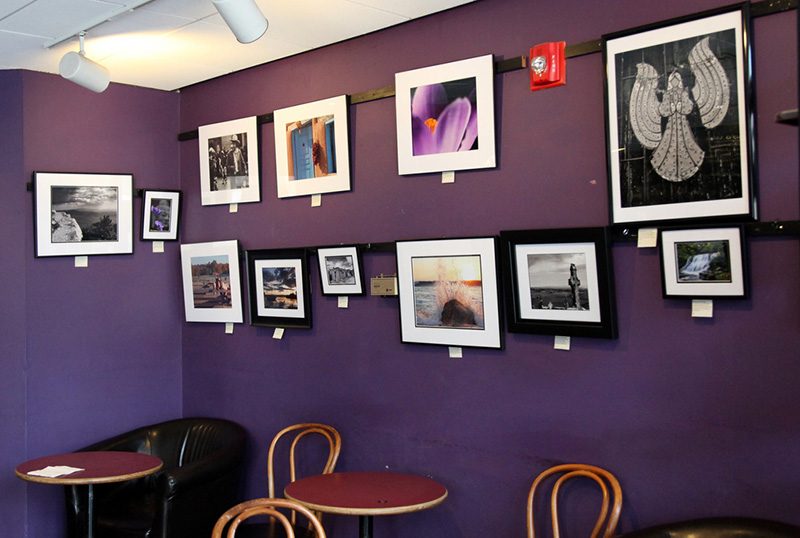
If you ever find yourself in Middletown, don’t miss out on a chance to stop in and order a cup of coffee! Klekolo has been serving Thanksgiving Coffee since the day they opened, and we love having the opportunity to work with Yvette and her awesome team of baristas. Check out some of these photos from recent visitors to Klekolo – the Best Coffee House in Connecticut!



Get a great cup of coffee at the address below:
Klekolo World Coffee
181 Court St
Middletown, CT 06457
(860) 343-9444
Monday • 6:30AM–10PM
Tuesday • 6:30AM–10PM
Wednesday • 6:30AM–10PM
Thursday • 6:30AM–10PM
Friday • 6:30AM–12AM
Saturday • 6:30AM–12AM
Sunday • 7AM–7PM
Check out our other cafes, restaurants and grocery stores on our Thanksgiving Coffee Store Locator page!
Klekolo World Coffee is the Best in Connecticut
read more -
![Solar Eclipse 2017]()
Solar Eclipse 2017
Cities and communities across the line of totality have been preparing for a once in a lifetime experience: a coast to coast total solar eclipse in the United States. From West Coast to East, the line of totality touches Oregon, Idaho, Wyoming, Nebraska, Missouri, Illinois, Kentucky, Tennessee, Georgia and South Carolina. The last time we had a total solar eclipse this viewable from North America was in 1918. It’s been almost a century, and folks have been waiting for this event for a long time. Do you have enough coffee to get you through the two minutes you’ll be in complete darkness? (we suggest a light roast to balance out the event)
(We had a little bit of fun creating a coffee bean eclipse below… enjoy! If it isn’t loading for you, you can view it on YouTube)

Foggy in Fort Bragg
Here along the Mendocino Coast, we’re keeping our fingers crossed for blue skies. We’re dead in the middle of Fog-ust (that’s coastal living for you!), so we’ll get the darkness, likely without that view of the ring around the sun. Below is a shot of a partial solar eclipse (which is what we’ll have here in Fort Bragg), in foggy Austria back in 2011.

Cristaudo’s in Carbondale
We have one account that is exactly on the line of totality, in Southern Illinois. As one of the best spots for viewing (the longest duration and most perfect eclipse), Cristaudo’s Cafe in Carbondale is preparing for a crazy weekend ahead. If you’re traveling that way to view the eclipse, be sure to stop by and grab a cup of coffee! They’ve stocked up on adorable eclipse-themed cookies, and have a great selection of Thanksgiving Coffee to offer.

Good luck out there!
Solar Eclipse 2017
read more -
![Roasters Guild Retreat]()
Roasters Guild Retreat
In the heat of Northern Georgia, the coffee roasting world is coming together for 18th annual Roasters Guild Retreat! We sent our Roastmaster Jacob Long, Roaster Joshua Long and Roastmaster Emeritus Paul Katzeff to the Lake Lanier Islands for a four-day roasting event.
Learn more: www.roastersguild.org

We’ll upload more pictures as the event continues. You can follow along on Instagram at the #RGRetreat hashtag, or on the @RoastersGuild Instagram page!
Roasters Guild Retreat
read more -
![National Honey Bee Day]()
National Honey Bee Day
August 19 is National Honey Bee Day!
Support the bees with Bee Bold Coffee!

Raising Awareness for Honey Bees
What’s the best way to celebrate National Honey Bee Day? Raise awareness for the plight of the bees – and learn more about what you can do to help. Take a moment to read the Friends of the Earth bee action page on protecting our pollinators, and share it on Facebook, Twitter, and other social media channels. This is a great way to raise awareness and inform your friends. Continue to scroll through that page for more information on pesticides, and the way neonicotinoids are hurting our bees.
Here’s an excerpt from the Friends of the Earth website:
Bees and other pollinators are responsible for 1 in 3 bites of food we eat. Without them, grocery stores would run short of some of our most important and nutritious foods. Coffee? You’ll need to cut back. Nuts and berries for breakfast? I don’t think so. A yummy salad? Your bowl will be nearly empty.
Pollinators are in great peril; their populations are declining around the world. Friends of the Earth works to eliminate pollinator-toxic pesticides like neonicotinoids and glyphosate and shift to organic farming systems that are healthier for bees, butterflies, people and the planet.
Thanksgiving Coffee Beekeepers
Did you know that Thanksgiving Coffee Company has it’s own beehive now? Back in June, bees swarmed in our apple orchard, and members of the Bee Bold Mendocino and local Mendocino Coast Beekeeping group helped us guide the swarm into our own beehive. Take a look at the video below!
Join the conversation on social media: Facebook, Twitter, Pinterest, Instagram
Thanksgiving Coffee Company
• Not Just A Cup, But A Just Cup •
National Honey Bee Day
read more -
![Kenya Peaberry: Latest Arrival for August]()
Kenya Peaberry: Latest Arrival for August
Every month, our Roastmaster Jacob Long chooses a coffee in our warehouse to spotlight for the month. Our Latest Arrival is the coffee that has been delivered most recently to the Thanksgiving Coffee Roastery, and you’ll find that these coffees astound every time.
 The latest arrival for August is our Kenya Nyeri Peaberry, and tasting this coffee at its freshest is not something to be missed. This light roast from Africa has a unique mouthfeel with hints of milk chocolate, ripe peach, and caramel. We’re especially fond of this single origin, because it helped solidify our title as 2017 Roaster of the Year, from Roast Magazine. Along with our Ethiopian Yirgacheffe and Paul’s Blend, the Kenya Nyeri Peaberry was judged during a blind tasting alongside a variety of other entrants – and came out on top. This year’s crop continues to perform well, and now that we’ve established this relationship with the Othaya group, we hope to see many more years of great tasting Kenyan Coffee. We had the opportunity to meet with Jim and Phyllis, representing the Othaya Cooperative, at the Global Coffee Expo back in April, and snagged this photo of them with our Roastmaster, Jacob Long.
The latest arrival for August is our Kenya Nyeri Peaberry, and tasting this coffee at its freshest is not something to be missed. This light roast from Africa has a unique mouthfeel with hints of milk chocolate, ripe peach, and caramel. We’re especially fond of this single origin, because it helped solidify our title as 2017 Roaster of the Year, from Roast Magazine. Along with our Ethiopian Yirgacheffe and Paul’s Blend, the Kenya Nyeri Peaberry was judged during a blind tasting alongside a variety of other entrants – and came out on top. This year’s crop continues to perform well, and now that we’ve established this relationship with the Othaya group, we hope to see many more years of great tasting Kenyan Coffee. We had the opportunity to meet with Jim and Phyllis, representing the Othaya Cooperative, at the Global Coffee Expo back in April, and snagged this photo of them with our Roastmaster, Jacob Long.
A week later, we received this note:
Raising Awareness for Honey Bees
What’s the best way to celebrate National Honey Bee Day? Raise awareness for the plight of the bees – and learn more about what you can do to help. Take a moment to read the Friends of the Earth bee action page on protecting our pollinators, and share it on Facebook, Twitter, and other social media channels. This is a great way to raise awareness and inform your friends. Continue to scroll through that page for more information on pesticides, and the way neonicotinoids are hurting our bees.
Here’s an excerpt from the Friends of the Earth website:
"Greetings Jacob.
It was so nice to meet you at SCA and learn that the coffee we produce helped you win Roaster of the Year. I am so glad our Othaya Peaberry performed so well. That is really a tribute to your ability to find the sweet spot of that coffee.
I hope you are just as happy with the coffees that come this year. As I mentioned Royal did a special project with us this year with red ripe cherries. If I recall correctly I gave you a few samples to cup. It will be good to hear what you think of them.
What made this project unique is that Othaya selected their best farmers to participate in the project and they agreed to wait from 10 to 14 days to pick only their best ripe cherries on the same day so they could be processed as a separate outturn (lot). Once the parchment completed the drying process it was immediately placed in grainpro and delivered to their dry mill. After dry milling it was immediately put back into grainpro and delivered to our warehouse and queued for hand picking improvement. The coffee will be hand picked in the next two weeks and shipped. You can expect this coffee to arrive around the end of July.
Best,
Jim"We’re looking forward to many more years of providing you with some of Africa’s best coffee. Order our Kenya Nyeri Peaberry Light Roast today, and try some of this truly fantastic, award-winning Kenyan Coffee now.
Kenya Peaberry: Latest Arrival for August
read more -
![It Takes a Village to Raise a Whale]()
It Takes a Village to Raise a Whale
When the body of an adult killer whale (Orcinus orca) washed ashore in 2015, the community of Fort Bragg was presented with a unique opportunity. In the wake of a tragic death, a project was born that could benefit the town and further our understanding of the sea creatures that live along our shoreline.
Beached orcas are exceptionally rare and their bodies are a treasure trove of valuable scientific information. In a combined effort between the Noyo Center for Marine Science, the Marine Mammal Center in Sausalito, the California Academy of Sciences, Humboldt State University, and California State Parks, scientists and volunteers acted quickly to perform a necropsy and recover valuable tissue samples. Two years later and the Noyo Center’s Orca Project is on track to reconstruct the 26 foot long skeleton this summer for everyone to enjoy.
Over the next four weeks, the rec center/basketball court behind Town Hall has been transformed into a marine mammal articulation workshop, led by master articulators Mike de Roos, Michi Main, and Lee Post from Alaska. People have come from far and wide to participate in this once in a lifetime opportunity, and there is something there for everyone. Young kids attending summer camp are learning about marine mammals and ecosystems, while high schoolers assemble their own porpoise skeleton. Grad students are taking measurements and gathering data, artists are photographing and sketching bones, all the while locals and tourists walk among them, drinking it all in, amazed by all the activity.
It takes a village to raise a whale skeleton; from recovering, transporting, cleaning, and housing the bones, to assembling the skeleton and raising it up for all to see. Everyone has a role to play, including Thanksgiving Coffee, who is keeping everyone working on the project well caffeinated. We are so enthusiastic about this amazing endeavor that we have also created a special Orca Project fundraising coffee to help support the mission of the Noyo Center.

It seems that our whole community has coalesced around whalebones, and Thanksgiving Coffee is no exception. Upon its completion, our small town will host one of the largest and most complete Orca skeletons in the world; something that the whole community can take pride in, because it took the whole community to achieve.
It Takes a Village to Raise a Whale
read more -
![A History in Nepalese Coffee]()
A History in Nepalese Coffee
In 1998, I was in Nepal. I was there because USAID offered me a free trip, provided I completed their mission.
The mission: to assess the coffee world in Nepal, from the farm to the cup. Nepal had some history in coffee production but it was in the distant past. Not much was known about Nepal’s coffee experience in 1998 – so they sent me to find out.
I was set down in a small city called Tenzen. I was housed in a small hotel in the foothills at about 5,000 feet above sea level. From my window I could see five 20,000 foot mountain peaks all lined up, covered in snow, and glowing golden in the late afternoon sun.
Nepalese Coffee Roasters
I soon found out how this trip came about; A local Nepalese coffee store owner who roasted his own coffee (selling to tourists and mountain climbers) had requested coffee information from the U.S. Government.
The question foremost on the mind of that local coffee roaster in Nepal was not how to build an industry that would benefit coffee farmers, but how to market his coffee to tourists. He was interested in helping himself, not growing the benefits of coffee for the many farmers who had coffee trees on their land. These farmers did not drink coffee, and had no ready market to sell into. I immediately re-organized my time and the people I needed to meet. I visited the farms and spoke with the coffee farmers. I soon discovered that my host, the Nepalese coffee roaster, was not liked by the farmers, because he paid very low prices for the coffee he purchased from them.
I got back to my USAID sponsors in the U.S. and told them they had been sold a bill of goods by a self-serving local businessman, and that I could not narrow my study to “How to develop a coffee roasting industry in Nepal” in good conscience. The potential was minimal, and very few would be helped with this mission. Those helped would be the educated middle class, not the poorer coffee farmers, who numbered in the thousands.
Word got back to my host and he was furious. This is not a good thing to happen to someone in a foreign country in the 90’s, where anyone could disappear in some back alley in Kathmandu, or under twenty feet of snow on some nearby mountainside. But I persevered. I decided (since I was already there) to teach the coffee farmers how to prepare coffee cherries for home roasting in a wok. I figured once they knew how to prepare coffee for consumption, they would have the basis for growing coffee for flavor. The idea was that knowledge would open up doors to export coffee, and bring in more money for their families in the future.

Nepalese Coffee Farmers
When I travel to a country to teach coffee to coffee farmers, I always bring green coffee samples from five or six countries to show farmers how the final product looks. It is important to know what green coffee looks like after the seeds are removed from the cherry, perfectly sorted, graded, and then processed for export. I want them to see what they are aiming toward. I also bring a small popcorn popper (110V) to roast the coffee samples if there is electricity available. In this mountain village there was none, so we rested a wok on three round stones over a bamboo wood fire.
This was a great teachable moment. In an open wok, you can see the changes as they come about. We sat around the fire, stirring the beans with a long stick. The heat from a bamboo fire is hot, very hot. As the coffee turned from tan to a dark oily black, I took small portions from the wok and allowed them to cool in a cool metal pie tin. After 15 minutes of wok-stirred coffee beans, we had all seen the changes and we had four separate samples to taste: Light Roast, Medium Roast, Dark and Very Dark (French Roast).

So we began by harvesting five pounds of their local coffee cherries. In the process of harvesting I taught the importance of “Red Ripe.” We de-pulped the cherries by hand (squeezing each cherry until the wet and slimy seeds popped out. Then we set the seeds out to dry on newspaper in the shade. It took five days to get the coffee beans to dry. They start out at about 50% moisture to about 25% moisture, and they need to be at around 11% to begin to roast. The weather was not cooperating, so I finished the drying in a wok over a low flame for a few hours. Then we let the seeds rest overnight.
Now we had Nepal samples and the roasted samples I brought from Mexico, Costa Rica and Nicaragua. Comparison tasting is a good way for novices to get an idea of their own coffee as it might fare in the export market against the quality of other coffees. In addition, we had the four different roast colors which I wanted to use to show them how they could get different flavors from the same beans.




My next week was spent teaching the principles of coffee roasting and coffee tasting . “If you don’t know what you are aiming at, you can’t hit the target,” I told them. So we spent time tasting and identifying flavors.



It should be noted that the Nepalese are tea drinkers, and chai is their drink of choice. So when I was asked how coffee was prepared in other countries, I told them it was a medium for carrying flavors. In the U.S. we used primarily milk and sugar, but in other countries coffee drinkers added other spices. I encouraged them to prepare coffee however they would enjoy it, and that is what they did. Coffee/Chai formulas were the order of the day, for the next week. Every family made their own version of coffee, and they were all different and delightful. Nothing I have tasted since has come close.
I wrote my report for USAID and sent it in (this was the 90’s, pre-email) and left Nepal via Kathmandu to Bangkok, and then to San Francisco. I left behind 200 farmers who had gained knowledge in roasting and tasting, but had no infrastructure to organize anything. My mandate was to assess the situation and my report gave a clear assessment: build the coffee agriculture in Nepal, and let the roasting trade find its own way. Help the farmers was my message.

It has been two decades since my report was sent off to USAID. I believed I had failed to create what the farmers needed, but I was wrong!
Life goes on and you can’t discount the power of knowledge and education.2017: Thanksgiving Coffee and Nepal
On Apr 5, 2017, almost twenty years later, I received this e mail from Mike at HimalayanArabica Nepal Coffee:
Hi Thanksgiving Coffee,
I found your company through Greenpages Org as we are also going through the application process and I wanted to take this opportunity to reach out to you to again.
HimalayanArabica believes in organic and ethical way of doing business and everyone along the supply chain from crop to cup can all benefit from doing business the right way.
Please give our coffee a try and you can get a free sample by simply emailing me your address and a phone number for the DHL packet.
I hope to hear from you soon and thank you for your time.
Kind regards,
Mike
Below is a shot of our Roastmaster Jacob Long on the left, posting with the same sack of Nepal Coffee as Michael Bowen, from HimalayanArabica on the right.

I replied on Tue, Apr 11, 2017
Mike,
This e mail was very nice to receive,
In 2001 I was sent to Nepal by USAID to evaluate the Nepalese Coffee situation.
I was part of a team of two. We were asked to come by a man who wanted to develop the tourist trade for roasted coffee in Nepal. My report stated my opposition to this plan as it would not have created a coffee industry , but only one or two farms to provide him with coffee to roast and to sell in Katmandu. I recommended the development of the cultivation of coffee so that many could benefit.
I am happy to see and know that my vision was clear and that in fact, aid and market forces (and Nepalese common sense) made the right situation happen and now 16 years later someone is offering me coffee from Nepal that I can roast and market.
For starters, who in the US is your importer that will handle the coffee ?
What is the availability and shipping date?
How many sacks are available?
What quality do you have ?
Has the coffee been cupped and scored by Q graders or would you venture a guess as to its quality?
Who is roasting coffee from Nepal now?
Send samples to Thanksgiving Coffee Company:
PO Box 1918
19100 South Harbor Drive
Ft. Bragg, CA 95437Thank you for taking the time to contact me. I am very interested and that is an understatement.
Paul Katzeff
CEO
Mike replied:
Hi Paul,
Thank you so much for your reply, it was very educational and got to understand a little piece of history of coffee here in Nepal. My name is Michael Bowen and I am a Korean-American grew up in Wisconsin. I spent some time in Korea and realized I wanted to do something else and somehow, almost magically, I came to live and work in Nepal and was given this fantastic opportunity to work with a company that has the same vision as I do, which is organic, ethical, sustainable and quality.
Raj, the owner, has been working tirelessly for more than 10 years to develop the farms in order for them to move towards the specialty market. Nothing is all set nor perfect here, but we are moving in the right direction.
Even though I have only come into the scene for a little more than a year, I can see that there is a lot of potential here which you undoubtedly saw 16 years ago.
Regarding your questions:
We do not have a dedicated US importer, at the moment.
There is about 8 tons available for shipment as soon as money is received and another 8-16 tons can be made available of the same quality from a different region after some weeks after the order is made.
We only have AAA specialty quality available for export.
Raj is a Q-grader himself and tastes the every batch that comes in. The samples we are sending out now have been sent out to various other graders from US, Europe and Australia and have scored between 83-86. Raj has scored this lot 85.5 SCAA standard.
There are several ‘roasters’ here in Nepal, but we also do our own roasts. Raj was the first to bring in equipment from abroad, from pulping machines to a roaster from Italy, but now there are several places where roasting is done. Raj, I believe, has the most experience roasting and you can check out our website at the ‘home’ section for testimonials for more reviews of our coffee and you can check out some roasted beans we offer.
We will send out samples this week and I will notify you the tracking number.
Kind regards,
Mike
That’s the story in a nutshell.
Time + Knowledge = Evolution.
We received the samples from Mike at HimalayanArabica, and I was surprised at the flavors and the cup quality. But I was more surprised at how good I felt about what I did twenty years ago in the hills of Nepal. I believed that I had failed to make change happen for those isolated coffee farmers, and that there was no hope for Nepalese Coffee.
Life goes on.
Paul Katzeff
Mendocino, California
A History in Nepalese Coffee
read more -
![Only the Strong Survive: A Story from New York]()
Only the Strong Survive: A Story from New York
I was born in The Bronx. I played stick ball. I hung out at the corner candy store. I bought two pretzels for 3¢.
We read comic books, which cost a dime. Once they were read, we traded them for 2¢. You could take your old comics out on the street, set them up on a wooden box, and collect your money for pretzels or an egg cream (8¢). The 50’s were pretty good for a kid. You could go anywhere in the city for a nickle subway ride, and you never thought it was dangerous.
I could tell you a million stories about growing up in the Bronx, including the time I went back in 1975, five years after I had left for California. I discovered that “my” candy store had become a Korean market. The soda fountain, comic books and telephone booths were all gone. (telephone booths were for the local bookies to take their bets and call in their bets they wanted to “lay off.”
I bought a t-shirt that stated The Bronx: Only the Strong Survive.
By the time I was 13 in 1951, I was traveling to Harlem to see the NY Giants play baseball at the Polo Grounds. One night, I remember sneaking into the Polo Grounds to see the Giants play the Cubs. I don’t remember the game at all, but I do remember what happened after the game…
It was about 11:30pm. I was waiting in the parking lot with my program for the ball players to come out of the locker rooms. Autographs were my goal. A reward for successfully sneaking into the game. It was dark, it was Harlem, it was late at night. All the cars were gone. There were no overhead street lamps to light up the parking area. But it was safe… or was it?
Where were the players? I had waited. Paid my dues, but nothing was happening as I watched the last few cars abandon me to being totally alone on a three acre unlit parking lot at midnight in Harlem. Then, a door opened and out came four players. The encounter went something like this:
#1: Hey kid, what are you doing here in the dark?
Kid: Waiting to get autographs.
#2: Where you live kid?
Kid: Palham Parkway.
#3: How you getting home?
Kid: I will walk over that bridge (138th st) to the subway and take the train home.
#4: Get in the car, we’ll take you to the subway station.
I got in the car and have no recollection of anything else. Thirty-four years later, while showing my six-year-old son my baseball card collection (the one most mothers are reputed to throw away), out popped the Giants’ 1951 program. I had not looked at it for over thirty years. Much to my surprise, it had three autographs on the cover and one inside. Who were these players who saw fit to rescue a 13 year old white boy from the long dark walk to the subway?

Willie Mays, Monte Irvin, Hawk Thompson. All Hall of Famers. Inside was Don Mueller, the 1951 national league batting champion. They’re the first four guys from the left on the bottom row of the photo below.

There is a lot of the Bronx still left in me. I had my first cup of coffee in the Bronx. They said it was mountain grown and good to the last drop.
Today, 65 years later, I want you to taste a Bronx-influenced blend of coffee I proudly named for myself (THAT’S Bronx Moxie!) I am proud of this blend. It took a lot of personal coffee experience to understand, as I eventually did, how to get the flavor profile I wanted. It’s a Bronx kind of coffee! Intense, heavy, with blueberry/strawberry notes and a long finish. The coffees are from Ethiopia and Nicaragua. Two countries where only the strong survive.
Paul Katzeff, co-founder and CEO of Thanksgiving Coffee Company
Only the Strong Survive: A Story from New York
read more -
![Fourth of July Mendopendence Parade!]()
Fourth of July Mendopendence Parade!
We had so much fun participating in Mendocino County’s Fourth of July parade! Check out a couple shots of our piece of the parade, and a few photos of the day…




A great drone flyover video of the July Fourth parade in Mendocino, from California Poppy Films. What a crowd!
The photos below of our Thanksgiving Coffee families were captured by Sam Koski Jones – thanks for sharing!


Fourth of July Mendopendence Parade!
read more -
![Coffee 101 : Roast Colors - What do They Mean?]()
Roast Colors: What Do They Mean?
It’s time to get educated.
Whether or not you have a go-to coffee, you probably have an idea of what you like. Something with a smoky taste, so you can add a splash of milk; or perhaps something on the sweeter side for your cold brew. We want to help you dig in a little deeper and learn more about every one of the roast colors, and what you’re tasting in your cup of coffee!
For each roast color, we’re highlighting a coffee that is really standing out right now. These recommendations come straight from our Roastmaster and Roastmaster Emeritus on what coffee they’re drinking these days. However, we DO want to encourage you to go outside the box, and take a look through all the coffees and roast colors on our website–try a variety to find that perfect cup!

Light Roast Coffee
Nuanced • Bright • Lively
In the lighter roasts (both light and medium), you can taste the nuance and impact of terroir. If you’re a single origin lover, these coffees are your go-to. With a light roast especially, the specific qualities unique to the coffee’s origin stand out. If you’re sticking with Vienna and French roasts (the darker beans), you have to work harder to tell the differences between origins. With light, it’s all there in the first sip.
For those of you that cup your coffee and take the time to taste every flavor, the lights and mediums are probably the roasts for you. When purchasing a single origin coffee, the great ones are best at this roast color.
Light Roast Recommendation
 Our Nicaraguan Flor de Jinotega is really making an impact right now. We received a fresh crop as of the beginning of June, and it’s tasting nutty, chocolaty, smooth and sweet. A really pleasing cup!
Our Nicaraguan Flor de Jinotega is really making an impact right now. We received a fresh crop as of the beginning of June, and it’s tasting nutty, chocolaty, smooth and sweet. A really pleasing cup!
Medium Roast Coffee
Nutty • Spicy • Balanced • Fruity
Roasted about 20 degrees Fahrenheit higher than the light, the color on a medium roast coffee bean shifts into a chocolate brown. As you move from the light roast to the medium, the bright and lively acidity morphs into a smoother, deeper, and more balanced mouth feel. In every sip of a medium roast, you’ll find that a certain mellowness and maturity prevails.
Medium Roast Recommendation
 Thanksgiving Coffee has many medium roasts that stand out, but our Fairtrade and Organic Mocha Java is a classic that we love more and more every time we brew it. This coffee has that balanced and nuanced flavor we referenced above, and was described as having a “delicately sweet aroma” by CoffeeReview.com, where it scored 90 points.
Thanksgiving Coffee has many medium roasts that stand out, but our Fairtrade and Organic Mocha Java is a classic that we love more and more every time we brew it. This coffee has that balanced and nuanced flavor we referenced above, and was described as having a “delicately sweet aroma” by CoffeeReview.com, where it scored 90 points.
Dark Roast Coffee
Bold • Spicy • Chocolaty
The coffee bean color on our dark roast (sometimes called the Vienna roast) is still more brown than black. You could compare it to the color of baker’s chocolate. When this coffee is freshly roasted, the beans will have a shiny coat of coffee oils on their surface. The greatest dark roast coffees will have hints of carbonization, but shouldn’t be described as smoky or toasty — we’ll leave those descriptors to the very dark roast.
Dark Roast Recommendation
 The preferred dark roast of the Thanksgiving Coffee Roastery right now is our Congo Coffee. Just launched earlier this year, this single origin is changing the way we think of dark roasts. As you sip this coffee, you’ll notice rich notes of chocolate and spice, with a syrupy mouthfeel.
The preferred dark roast of the Thanksgiving Coffee Roastery right now is our Congo Coffee. Just launched earlier this year, this single origin is changing the way we think of dark roasts. As you sip this coffee, you’ll notice rich notes of chocolate and spice, with a syrupy mouthfeel.
(Bonus Points: every purchase of our Congo Coffee benefits the Dian Fossey Gorilla Fund International!)
Very Dark Roast Coffee
Toasty • Smoky • Caramelized Sugars
Ah, the “French Roast.” This is the coffee that goes great with a splash of milk. The coffee bean color on our very dark roast is more black than brown, with rich and copious levels of surface oil. Roasted long and hot to produce deep carbony, smoky flavor notes. A well-made French roast will have caramelized sugar notes, licorice and roasted chestnut flavors, and a long wet (not ashy) finish.
Very Dark Roast Recommendation
 We recommend the Sumatra as our very dark roast selection for a very good reason: you don’t find many single origin coffees that are roasted to this color. It takes some work to create a French roast that still has the flavors and nuances of origin, and this coffee does that well.
We recommend the Sumatra as our very dark roast selection for a very good reason: you don’t find many single origin coffees that are roasted to this color. It takes some work to create a French roast that still has the flavors and nuances of origin, and this coffee does that well.
As we sign off on our roast color education, we want to remind you of something: if you aren’t sure you’ll like it, give it a try! Are you regularly a French roast lover? Give medium a go. Religiously purchase the Bolivia Light Roast? Add the Rwanda Medium to your order this month for something new. The best way to develop your taste preferences is to get outside your box and liven up your selection.
Enjoy your roast color adventure!
Oh yes, you CAN blend different roast colors! Paul Katzeff created an app for all you iPhone users to explain this even more. It’s called Smart Coffee, and it was designed to help you blend roast colors, and create a flavor profile that is specific to YOU. Check it out!
Coffee 101 : Roast Colors - What do They Mean?
read more -
![Kona Cold Brew Marinade for Pot Roast]()
Kona Cold Brew Marinade for Pot Roast
From Lawrence Bullock
Here’s a cold brew marinade for those foggy summer weekends (or anytime, actually) when company’s coming, and you have a bit of prep time. You will need a full two days for prep, and another ten hours for the slow cooker.

Cold Brew Recipe:
One 12oz package of Thanksgiving Coffee Kona Blend, cold brewed for 24 hours. I used our Cold Brew Kit. Once the cold brewing was complete (24 hours) I filtered the coffee using a mesh filter. If you don’t have one of those, simply pour off the cold brew into a second container until you see the sludge. Set the strained cold brew aside. Discard any solids left at the bottom of the cold brew kit, and you’re left with roughly 50 to 56 ounces of cold brew coffee.I bought two chuck roasts. Chuck roasts are an inexpensive cut, but flavorful.
I put the cold brew into a container that I knew could contain the roasts and the cold brew. A lidded container is preferable, but if you don’t have one, use cling wrap to seal it off. Use enough cold brew to completely cover the meat.
I then placed the meat, covered in cold brew, in the refrigerator for 24 hours. Once the cold brew marinade process was over, I poured the leftover cold brew coffee into a container and set it aside.
As you can see, planning ahead is essential as two 24 periods are involved, and THEN a ten hour cook time.
<But it’s worth it.
br>I then used the directions on a product called Johnny’s French Dip Au Jus. This product can be found in most grocery stores, or online, these days. You only need one little bottle, but I usually buy two and keep one in the pantry. Johnny’s French Dip Au Jus contains: Water, Hydrolyzed Vegetable Protein (Corn, Soy, Wheat), Red Wine Vinegar, Tomato Paste, Worcestershire Sauce. The basic recipe for the au jus, according to the label on the little bottle is two parts water to one part au jus. Instead of the recommended water, I used the cold brew that I had marinated the roasts in. Using those directions, I ended up with 3 cups of au jus liquid. It pretty much covered the roasts. You can make more of the au jus if you wish. Make enough to cover the roast (or roasts) completely.
I refrigerated any remaining cold brew to save in case it was needed. Any product that has touched raw meat should be refrigerated.
Cooking the Pot Roast
I set the slow cooker to ten hours and let it cook. For ten hours.
A coffee-saturated roast beef was the result. The coffee flavor was evident but not overwhelming and taste tests went well. A wide rage of ages (15 to 67) tasted the roast at completion and enjoyed it.
I didn’t really need the extra cold brew marinade so I discarded it. For health and safety reasons, I didn’t freeze it, or save it for later. Any product that has touched raw meat should be discarded if not used in a timely fashion.
You can add carrots, potatoes and any number of vegetables associated with standard pot roast recipes, but I chose to not include them in this recipe because I wanted to taste what a strict coffee au jus and meat only combination tasted like. I’m sure adding the vegetables would be just fine, and I’ll probably do that next time!
Kona Cold Brew Marinade for Pot Roast
read more -
![Hot Coffee, Cold Coffee: How Does Temperature Affect Taste?]()
Hot Coffee, Cold Coffee: How Does Temperature Affect Taste?
From Lawrence Bullock
Biologists have only recently started understanding how and why temperature affects the taste of food and beverages. No research has been conducted specifically regarding coffee. But there are three main theories; the first holds that lukewarm coffee tastes bad because cavemen didn’t have refrigerators.
Karel Talavera of the Laboratory of Ion Channel Research in Cuba has studied the way that taste receptors inside our taste buds respond to molecules at different temperatures. He and his colleagues found that certain taste receptors are most sensitive to food molecules in the 20 to 35 degree Celsius (68 to 95 degree Fahrenheit) range — in other words, molecules at or just above room temperature. The taste receptors in question don’t always register molecules much hotter or colder than this range, so we don’t taste them.
“This is still an obscure phenomenon that we cannot explain, but that could fit to the fact that taste perception does decrease above a certain temperature,” Talavera says. In short, hot coffee (around 170 degrees F) may seem less bitter than room-temperature coffee (73 degree F) because our bitter taste receptors aren’t as sensitive to bitter molecules in the coffee when those molecules are hot.
According to Talavera, our sensory systems tend to be designed by evolution to perform most effectively at the temperatures we are typically exposed to. “Our ancestors did not eat food at extreme temperatures,” he said. Their meals consisted of mostly foraged berries and freshly hunted meat in the 20 to 37 degree Celsius range — almost exactly the window in which our taste buds are most sensitive. Because piping hot or ice-cold coffee falls outside this realm of maximum taste, our taste buds don’t sense the drink’s true bitterness.
However, the temperature-dependence effect observed by Talavera and colleagues is more pronounced for sweet taste receptors than bitter ones, and so it may not be the only factor at work. Some researchers think tepid coffee’s bitterness has more to do with smell than taste. “Odors influence coffee flavor very strongly, and it is easy to go from sublime to horrible,” Paul Breslin, an experimental psychologist who studies taste perception at Rutgers University, wrote in an email. Even very bitter coffee, such as espresso, tastes great when hot because of its pleasant aroma, he pointed out.
According to Barry Green, a taste perception scientist at Yale University, hot coffee releases more aromatic compounds than room-temperature coffee, so it has a greater chance of impacting taste. He also said that milk, coffee’s frequent companion, tastes worse at room temperature, and a combination of these factors probably explains the nearly universal opinion that lukewarm coffee leaves something to be desired.
One last theory holds that hot coffee’s heat could be distracting us from its strong flavor. As Breslin put it, “It is possible that an attentional mechanism is at work. You do not think about how bitter or sweet [coffee] is when it is hot or cold. Hot coffee may force you to think about temperature, which is a bit of a distraction from its bitterness.”
None of the researchers profess to fully understand coffee’s temperature-dependent deliciousness, but it seems to be at least slightly, only a matter of opinion.
Below: A photo featuring both hot coffee and cold coffee from one of our cafes, The Good Earth Coffee and Tea House in Oroville, California!

Hot Coffee, Cold Coffee: How Does Temperature Affect Taste?
read more -
![Take Your Dog to Work Day]()
Take Your Dog to Work Day
Friday, June 23 is Take Your Dog to Work Day! Then again, for a few of us here at Thanksgiving Coffee Company, everyday is take your dog to work day. Meet two of our office pups, Zoe and Brutus!


Zoe was adopted from the Border Collie Rescue of Northern California. These guys serve most of Northern California, re-homing animals that need new situations and families that will take care of them. Zoe’s mom is Patty, from our accounting team. Patty has been a part of the Thanksgiving Coffee family for 28 years, and Zoe for 8 of those years!

Brutus is a newer addition to our office. Co-founder and CEO Paul Katzeff adopted Brutus from the Mendocino Coast Humane Society just two months ago! He’s already adjusted nicely to life at our headquarters, although we found out he does not like to pose for photo shoots.

Thanksgiving Coffee Company has partnered with the Mendocino Coast Humane Society to create a Cause Coffee that benefits their shelter. This non-profit has been serving Fort Bragg and beyond for over thirty years. We are proud to be a part of their fundraising efforts, and stand with an organization that is doing good for the animals of our community! Learn more on the MCHS Cause Coffee page.
Take Your Dog to Work Day
read more -
![Boonville Coffee for Sierra Nevada!]()
National Trails Day at Pelican Bluffs
This weekend is the 24th annual Sierra Nevada World Music Festival, and it’s one of the Mendocino County events that is not to be missed. As you’re driving to and from the festival and need a coffee fix, here are a couple places to stop by and grab a cup of Thanksgiving Coffee!

BOONVILLE
Lizbby’s Restaurant and Bar
Anderson Valley Market
Redwood Drive In
PHILO
Stone and Embers
Lemon’s Market
The Bewildered Pig
NAVARRO
YORKVILLE
CLOVERDALE
Dahlia and Sage
Eagles Nest Deli
The Upsetter (Espresso)
Did you know that our Upsetter Espresso Blend is a reference to one of our favorite reggae artists? Lee “Scratch” Perry will be performing at Sierra Nevada this year. The label design on our Upsetter (a light roast espresso blend) is a reference to his label: Upsetter Records. Can’t wait to see him perform this weekend!

Have fun at Sierra Nevada… maybe we’ll see you out there!
Boonville Coffee for Sierra Nevada!
read more -
![For the Birds: Altamira Oriole]()
For the Birds: Altamira Oriole
For the Birds is a blog series from Thanksgiving Coffee Company, highlighting one of the 200 Neotropical migratory birds who rely on shade grown coffee during their winter migration. In January, we featured the Cedar Waxwing, in February, the Magnolia Warbler, March was the Blackburnian Warbler, and to celebrate the re-release of our Song Bird Decaf, we are featuring the Altamira Oriole!
Altamira Oriole
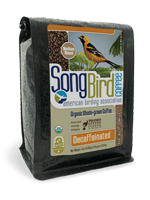
Song Bird Decaf Medium Roast Coffee
The striking orange and black plumage of the Altamira Oriole (icterus gularis) graces the label of our newly re-released Song Bird Coffee Decaf, and with good reason. This delicious Smithsonian Migratory Bird Certified coffee is decaffeinated with a clean, all-natural mountain water process in the Chiapas region of southern Mexico, home of the Altamira Oriole.

The Altamira is a large oriole and builder of the longest nest of any bird in North America. In the United States their range is limited to the Rio Grande Valley of southern most Texas, but their nests are a common sight throughout Mexico and Central America.

The female bird uses the inner bark of trees, retama leaves, various grasses, and occasionally Spanish moss and plastic twine to create one of nature’s architectural marvels. Over the course of several weeks, she painstakingly weaves a two-foot long basket that hangs over an open space, road, or river, suspending her fragile eggs thirty feet above the ground.

While many species of birds specialize in hiding their nests from the eyes of predators, the Altamira Oriole takes a different approach by building a home that is wildly conspicuous, but impossible to reach.
 All of Thanksgiving’s organically certified coffees are shade grown, and a select few carry the Bird Friendly gold seal of the Smithsonian Migratory Bird Center. This certification ensures that tropical “agroforests” are preserved and migratory birds can find a healthy haven to eat and rest as they travel the hundreds of miles from your backyard to the coffee farms producing the beans you so enjoy every morning.
All of Thanksgiving’s organically certified coffees are shade grown, and a select few carry the Bird Friendly gold seal of the Smithsonian Migratory Bird Center. This certification ensures that tropical “agroforests” are preserved and migratory birds can find a healthy haven to eat and rest as they travel the hundreds of miles from your backyard to the coffee farms producing the beans you so enjoy every morning.
You don’t need binoculars to find a coffee that protects forests, helps wildlife and supports the efforts of the American Birding Association; just look for the Songbird Coffee with the Altamira Oriole on the front.
For the Birds: Altamira Oriole
read more -
![Join the Fight to Save Our Wild Horses]()
Join the Fight to Save Our Wild Horses
Thanksgiving Coffee, an industry leader in social and environmental justice for over forty years, stands in defense of our wild horses. The vanguard of fair trade shade-grown coffee, Thanksgiving has helped their nonprofit partners raise much-needed funds to champion their missions through the Cause Coffee fundraising program. And now, Thanksgiving is proud to support the efforts of the American Wild Horse Campaign (AMWC) with the release of Wild Grounds Coffee.

Save Wild Horses
Today, both livestock and wild horses have the right to roam the range, but the political power of the cattle ranchers is stronger then the political power of wild horses. In the forty years since a bill was passed by congress to protect the wild horses, moneyed interests have worked tirelessly to chip away at it. Now, the use of our publicly owned grazing lands is being prioritized to create market value for ranging cattle, which only provides for 3% of America’s beef consumption.
Unable to cull the herds or sell them for slaughter, the BLM began to round up what they considered to be an excess population. Today 35,000 horses, more than their entire population in the 1970’s, are kept in government holding pens. Not to be killed, yet never again to be free; this is a terrible fate to befall the national symbol of perseverance and freedom.
“The whole thing is cruel and lacks any sense of the American Spirit”, says Paul Katzeff, CEO of Thanksgiving Coffee and Past President of The Specialty Coffee Association of America, “We just gotta do something about the suffering to restore our own sense of freedom. Can you imagine the conditions? Thirty-five thousand wild horses in shadeless pens in 100 degree heat waiting to die?”

The American Wild Horse Campaign
The American Wild Horse Campaign is a champion for America’s wild horses and burros and they have been calling on Congress to reform the current ‘holding pen’ policies. Not only would such methods keep these animals in the wild, where they belong, it would also save taxpayers millions of dollars annually by no longer funding the removal of wild horses from the range and stockpiling them in government holding facilities and paying for their feed and water and medical needs.
Thanksgiving Coffee Company, 2017’s Roaster of the Year, is sending Wild Grounds coffee out into the country with the mission to raise funds and educate others about the plight of our wild horses. Together, we will stand in defense of the mustangs who have an inalienable right to roam the western landscape, just as we stand up against those who would profit from their incarceration and eradication.
 We invite you to join us. Stand up for America’s wild horses and the pioneer spirit we all share. Order a package of award winning Wild Grounds coffee and you are not just supporting the horses; you are also supporting fair trade for the farmers, organic shade-grown coffee that preserve rich jungles forests, and the ethical standards of a certified B corporation. Since 1972, we have been proud to bring you a beautiful cup of coffee that tastes just as good as it feels.
We invite you to join us. Stand up for America’s wild horses and the pioneer spirit we all share. Order a package of award winning Wild Grounds coffee and you are not just supporting the horses; you are also supporting fair trade for the farmers, organic shade-grown coffee that preserve rich jungles forests, and the ethical standards of a certified B corporation. Since 1972, we have been proud to bring you a beautiful cup of coffee that tastes just as good as it feels.
Not Just A Cup, But A Just Cup.
Join the Fight to Save Our Wild Horses
read more -
![Roastmaster’s Select: Colombian Coffee]()
Roastmaster’s Select: Colombian Coffee
We’ve sung the praises of our Roastmaster’s Select Club before. An all-new coffee every month, micro-lots that you won’t see anywhere else, small batch roasts, and limited editions that taste magnificent.
But if you aren’t ready to take the plunge and sign up for a blind monthly club subscription, we have another option. Every few months, we pick a favorite from the club, and feature it here on our website for non-members. We’ve featured coffees from Panama, Kenya, Ecuador, Nicaragua, and more in the past months.
What’s up next? Our Colombia Medium Roast from the Cafe Colsuaves co-op.

Coffee From Colombia
Thanksgiving Coffee has sourced coffee from Colombia for years, and it continues to be a favorite origin of ours. We found this lot of coffee while searching for unique Colombian coffee for our club members. Roastmaster Jacob Long sample roasted the green coffee, and blind tasted it alongside a variety of samples — finding this Colombian to be a real stand-out.
This coffee is sourced from the Popayan region of Cauca, on the western side of Colombia. We ended up purchasing 500 pounds of this micro lot, and we’re impressed with the way it turned out. It’s quite smooth and nuanced, with a great body and flavor. The Cafe Colsuaves group produces brilliant coffees by putting a strong focus on lot separation and processing control, creating some truly unique micro-lots.
Colombian Medium Roast
Jacob created a roast profile that brings out the natural flavors of this Colombian, and everyone here at the roastery is loving how it tastes. This Medium Roast is rich and smooth, with complex notes of milk chocolate and vibrant citrus undertones. At the Thanksgiving Coffee tasting room, we especially love it in the Soft Brew, and we’re planning on trying it in our Cold Brew Kit later this month.
Give the Cafe Colsuaves Colombian Medium Roast a try. Add this coffee onto your next order, and we’re certain you won’t be disappointed. Don’t wait too long to get this coffee delivered! In just a few weeks, we’ll be rotating it out for a new Roastmaster’s selection!
Roastmaster’s Select: Colombian Coffee
read more -
![Coffee from Rwanda]()
Coffee from Rwanda
I was trailing off to sleep, it was a cool summer night in Mendocino. Joan’s voice came into my consciousness and broke my reverie. She was not yet ready to say good night to the day.
“Paul, I was listening to NPR today and there was this story about the poverty and the general plight on the African Continent. I think we need to begin focusing on buying coffee and supporting cooperatives in Africa like we do in Central and South America.”

Of course I agreed, and dozed off to spend some unconscious time thinking about the idea and all the effort it would take to be as bold an activist in Africa as we were then (and now) in Central America. I hoped that when I awoke in the morning my mind would have used the eight or so hours sleeping to clarify. I had no intention of just jumping into more work.
What Joan was asking was not simple but as President of Thanksgiving Coffee she did have a big voice in things such as this. We would have to pick the countries we wanted to work in, we would need to take sixteen hour flights, we would have to find communities we could work with, we would need to buy coffee in container loads to be effective. A container load is 37,500 pounds. We would have to build a demand for these new coffees or we were going to have to buy less of other coffees, which hurts the farmers we are already working with.
That morning at work, an amazing thing happened.
I received a phone call from a professor at Michigan State University. She had recently received a USAID grant to help the Rwandan Coffee industry create a market plan for their reentry into the Specialty Coffee market, specifically aiming at the United States craft coffee trade. Yes, the entire country’s coffee industry!
How serendipitous is that? One moment we are lying in bed thinking, and the next day the answer and the challenge arrives on the phone.

They asked Thanksgiving Coffee to be part of a small group of coffee experts. We would fly to Rwanda in three weeks to help a country only ten years from its genocide in 1994. A genocide that saw 900,000 Rwandans murdered by their fellow countrymen, and their entire coffee infrastructure destroyed in the process. I wanted us to be there to help, but I said to Joan after the phone conversation: “Joan, you started this last night, and your answer and opportunity came this morning so I think it is YOU who will have to fly to Rwanda in three weeks.”
And that was the beginning of our now fourteen year odyssey with the Rwandan coffee farmers.
Trips to Rwanda

On that first trip to Rwanda, I remained in Mendocino. It was a first for us; me staying home and Joan going to do the exploring and experience the adventure.
On her first day in Rwanda, she met with the Dian Fossey Gorilla Fund International Executive Director, who was interested in linking the Rwandan coffee industry with saving the last 400 Mountain Gorillas, something Dian Fossey was murdered for trying to do. Joan saw the opportunity, and said that Thanksgiving Coffee would create a marketing plan for linking Rwandan coffee to Mountain Gorillas. That is how – on DAY ONE of Joan’s first trip to Africa – Gorilla Fund Coffee was born.
When things are supposed to happen, they do.
But usually, not so fast.

Joan went to tour the gorilla habitat, trekking for hours into the Virunga National Forest and was gifted by coming upon a family of Mountain Gorillas, led by a 500 pound Silverback. In her words:
“The rain is soft, the trail slippery and muddy. We’re moving quickly, breathing hard in the thin high-altitude air. Intent young trackers radio one another, ‘We are close.’ Suddenly the Amahoro Gorilla family crosses our path. Wow! What a sight. Two young gorillas grasp the pant legs of a couple in our group before bounding off to join the adults – which included a 500 pound Silverback. I am transfixed and transformed in the presence of these gentle giants. I still can not believe I was there and it really happened.”
My own experience with the gorillas in Rwanda came a year later. I got a chance to hang out with a different family of gorillas. I sat cross-legged, facing the Silverback leader for 45 minutes exchanging grunts every so often but never allowing our eyes to meet. He had a very intriguing aroma about him. Musty, earthy, very Sumatra coffee-like. It was clean and powerful. I would recognize it anywhere. And yes, I did read the novel Ishmael about the Silverback Guru teaching a journalist about life’s questions. I sat with my Silverback thinking he might just know a lot more than me about the meaning of life. He had big Brown eyes.
I took his portrait picture and it adorned our Gorilla Fund Package until 2016 when it was removed in favor of a younger gorilla image.

Building in Rwanda
On my second trip in 2005, I met with the Director of the USAID project and we mapped out a quality improvement plan to make Rwanda coffee the best it could be. We wrote a proposal which was funded the following year. It was a plan to put a tasting laboratory at every coffee cooperative so the farmers could separate their coffees and evaluate each lot individually.
This was a great advance at the time, and it put Rwanda in the running to be one of the most advanced coffee regions in all of Africa. This project gave me the opportunity to travel the countryside and visit many growing regions and finally find the Dukunde Kawa Coffee Cooperative in Mussasa. It is the coffee we have purchased for the past 12 years and has won the reputation of being the best of Rwandan coffee for the past five years in the Cup of Excellence competitions held yearly. We use that coffee to help save the gorillas.
Gorilla Fund Coffee has raised over $100,000 for DFGFI, since we began this program in 2005. Joan and I have attended many DFGFI celebrity fundraisers given in big city venues as honored guests for Thanksgiving Coffee’s work educating coffee lovers about the Mountain Gorillas. At one event I met and had a conversation with Gloria Steinem, at another I spoke with Sigourney Weaver who played Dian Fossey in the movie Gorillas in the Mist.
Now we are partnering with DFGFI to inform the American Coffee drinkers about the plight of the Grauer’s Gorilla who is Critically Endangered in the Democratic Republic of Congo. In my youth, this area was known as “deepest, darkest Africa.” Using the same idea, we went after finding a good coffee from the Congo to represent the Grauer Gorilla, that we would create a dark roast from.

Congo coffee is new to the pantheon of craft coffees. It is a country rife with political instability and crazed rebels who wreak havoc on villages. In 2013, I turned down an invitation to visit the Congo by my long time friend Richard Hyde of Cafe Direct who was working with a group of coffee cooperatives there. He knew I could be a buyer, but I had enough coffee and the Grauer’s Gorillas that make their home in the Congo had not yet come upon the DFGFI’s radar.
Three years later, the DFGFI began to work in the Congo, and I called my friend Richard to find out where I could get the coffee that comes from the mountains where the Grauer’s Gorillas reside.

In the beginning of this journey, we realized that it was the gorillas that could help the Rwandan people. Not many Americans will go out of their way to help the Rwandan people but all Americans want to support the Mountain Gorillas. So we focused on the gorillas to build the value and demand by consumers for this coffee.
We used the Fairtrade model and certification to give money back to the Dukunde Kawo Coffee Cooperative. We created a climate change mitigation program and financed shade tree planting. We even funded a milk cow project to supply each family with whole milk and cheese for family use and for added income. Every sale of the Gorilla Fund coffee benefited not only the gorillas, but also the members of this Rwandan Coffee Cooperative called “Dukunde Kawa”, which means “Great Coffee”. We intend to follow that same model to inform the public of the Endangered Grauer’s Gorilla, and support industry in the Congo.

It isn’t easy to do this kind of work in coffee. Lot’s of collaboration needs to be built into the process. There is always the risk that too much coffee will be purchased and sales will not match up. But we do this work for other reasons. Coffee is the medium, but it is not the message. This is how we work now with the American Birding Association, to save Migratory Song Birds, with Friends of the Earth to save Pollinators, with Defenders of wildlife to save our Wolves and soon, with more partners to save our wild animals.
So join us in our efforts and purchase these coffees and together we will make a difference.
Paul Katzeff, co-founder and CEO
Coffee from Rwanda
read more -
![Roaster of the Year: Thanksgiving Coffee Company]()
ONCE IN A LIFE TIME AWARD
We are beyond excited to announce that we have been chosen as the 2017 Macro Roaster of the Year! This prestigious award is chosen through a vigorous process by Roast Magazine, and we are so honored to have been selected.
Pictured Below: The Thanksgiving Coffee team outside our Fort Bragg headquarters
Roaster of the Year Selection Process
The selection process at Roast Magazine is truly impressive. In order to apply, the team at Thanksgiving Coffee compiled a 30 page booklet, outlining some of the most fascinating aspects of our company:
- Our humble beginnings in 1972, along the Mendocino Coast.
- The history of the causes we’ve supported over the past 40+ years.
- Farms and co-ops that we’ve worked with for decades.
- Our certifications we have acquired over the years.
Pictured Below: CEO Paul Katzeff at the original headquarters in Noyo Harbor
Choosing the Coffee: Blind Tasting
Being Roaster of the Year is not just about what we've done or where we came from… it’s about the coffee. After choosing the finalists from the information submitted to them from coffee roasters around the globe, Roast Magazine does a blind taste test. More from Unpacking Coffee Video
Pictured Below: Roastmaster Jacob Long in the Roastery
For this test, they asked each finalist to submit three roasts, and our roastmaster Jacob Long made the decision:
“This is an international competition, we were competing against the best artisan roasters from around the world. With so many great coffees to select from, I chose to present the judges with a few of our freshest coffees with amazing flavor profiles, vibrant and rich Kenyan Peaberry, floral Ethiopian Gedeb, and the beloved fruity-chocolatey Paul’s Blend.”
These coffees were sent to two separate cupping labs for the blind tasting. The judges at these labs scored all of the coffees presented by the finalists, and then combined those with the scores from the written submissions. The top rated coffee company is then selected as Roaster of the Year.
Each of these award-winning roasts is available through our Thanksgiving Coffee online store!
2017 Macro Roaster of the Year
The Roaster of the Year announcement was made at the Let’s Talk Coffee conference in Puerto Vallarta, where our Vice President Jonah Katzeff accepted the honor. During this event, Jonah also had the opportunity to meet with the great people of Sustainable Harvest, the Specialty Coffee Association of America and so many more movers and shakers in the coffee industry.
Pictured Below: Vice President Jonah Katzeff accepting the award at Let’s Talk Coffee
We want to say THANK YOU to our fans, our friends and family, and everyone who has supported us over the 44 years of coffee roasting. This is such a huge honor, and we can’t wait to share even more of our coffees with the world over the next year!
Roaster of the Year: Thanksgiving Coffee Company
read more -
![Flight Beyond Borders]()
A celebration of International Migratory Bird Day

Here in the United States, we sometimes claim a cultural ownership of beautiful birds like the Baltimore Oriole, perhaps forgetting that the very same species could just as easily be named the ‘Panama Oriole’, or the ‘Nicaraguan Oriole’, as it spends half it’s life in Central and South America. IMBD is a reminder that the health and abundance of these birds that are so much a part of our heritage does not stop at our own backyard feeders. If we wish to enjoy their beauty and their songs for generations to come, we must care for them and their well being across all borders.
The growing demand for coffee, and the rise of the mono-cultured full sun coffee plantations, has demolished much of the wintering habitat for iconic birds like Orioles. In fact, many of these species are now referred to as ‘Coffee Birds’ because the only forest home left to them are the shade-grown coffee farms that preserve the jungle canopy.
For over 20 year, Song Bird Coffee has been a leader in supporting the farmers who protect their native forests by growing delicious coffees under the jungle canopy, preserving priceless habitat and biodiversity. This year, on International Migratory Bird Day, we hope you will join us in protecting our precious songbirds, just by enjoying a great cup of shade-grown coffee.
Flight Beyond Borders
read more
